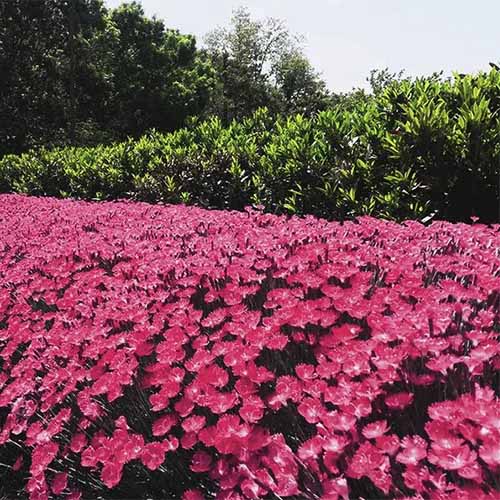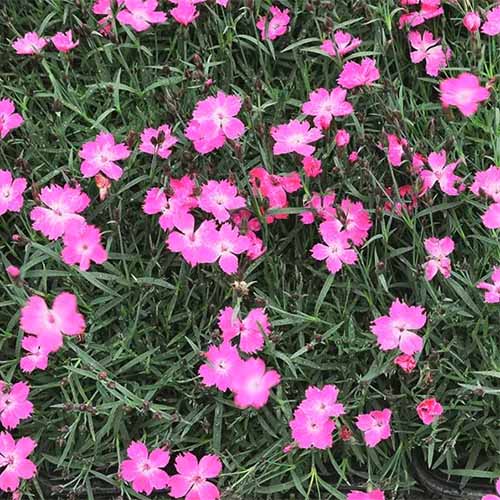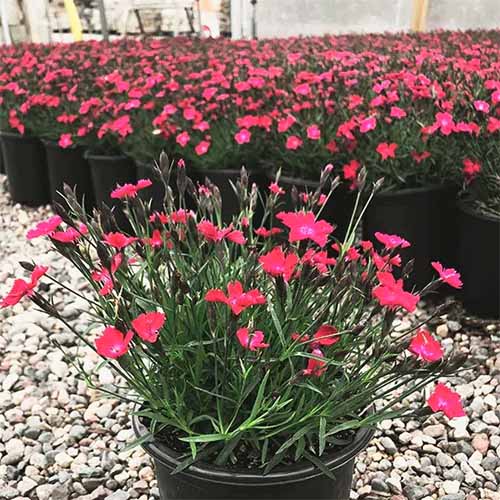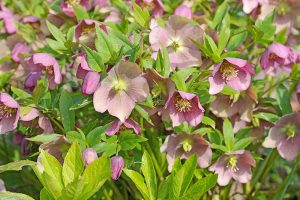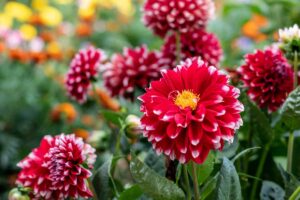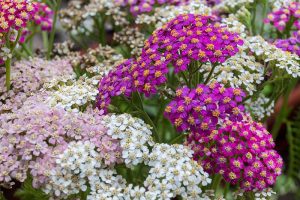Dianthus superbus
A classic in the cottage and cutting garden, dianthus species are beloved for their sweetly spicy fragrance and bright, cheerful flowers that rise above cool, glaucous green foliage.
Large pinks feature feathery flowers in intense shades of burgundy, lilac, pink, scarlet, and white with deeply cut, fringed edges that can be delicate and silky or wildly plumed.
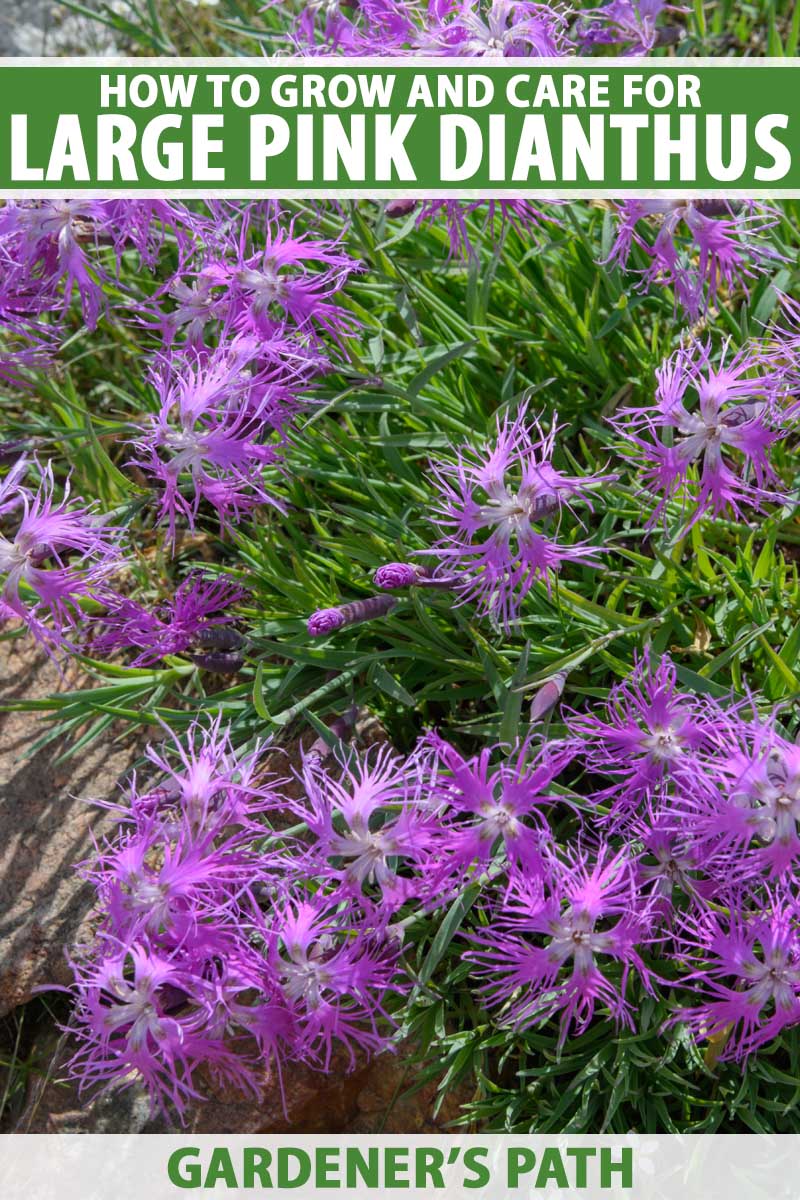
We link to vendors to help you find relevant products. If you buy from one of our links, we may earn a commission.
Their long stems, sparkling flowers, and strong, spicy scent are ideal in beds, borders, containers, edging, and rockeries as well as butterfly, courtyard, gravel, and zen gardens.
Flowering vigorously from late spring to midsummer, plants self-seed readily, forming tidy mounds or dense mats that are highly attractive to pollinators like bees and butterflies but resistant to deer.
And they make a magnificent, long-lasting addition to cut flower arrangements as well!
So if you like ornamentals that are easy to grow, fragrant, and drop-dead gorgeous, sit back, relax, and learn how to plant and grow large pinks.
Here’s what’s ahead:
What You’ll Learn
What Are Large Pinks?
A cold-hardy, herbaceous perennial native to parts of northern Asia and Europe, large pinks, D. superbus, belong to the genus Dianthus and are also known as superb or fringed pinks – although other species like D. monspessulanus also use the common name fringed pink.
D. superbus contains six subspecies including the popular D. superbus subsp. superbus and D. superbus subsp. longicalycinus.
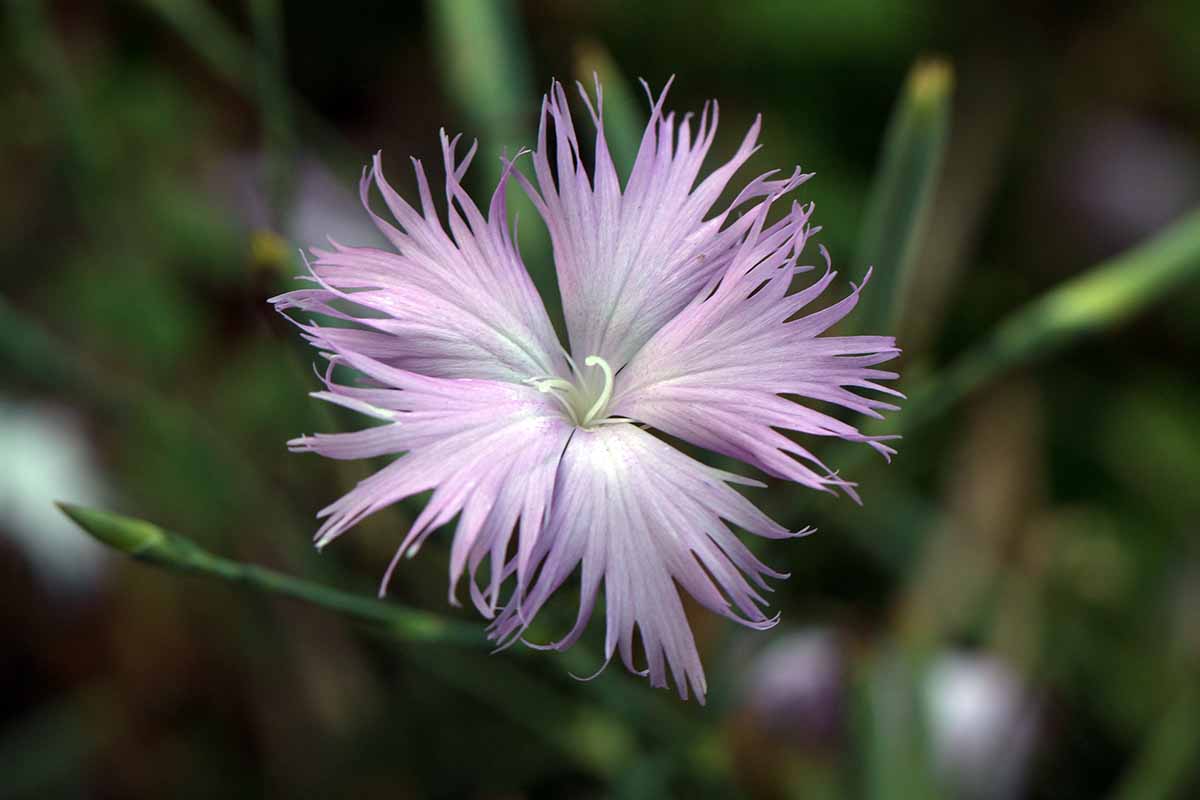
The plants feature shaggy and deeply fringed, five-petaled flowers measuring up to two inches across in shades of crimson, lilac, and white. And the blooms are beautifully offset by mounding clumps of blue-green, elliptical foliage.
Growing 12 to 20 inches on upright stems, the single or double flowers have a strong scent of sweet cloves and appear singly or in doubles at the tips, attracting beneficial pollinators while repelling deer.
Indigenous to rocky slopes and woodland fringes, large pinks flower most prolifically in the cooler temperatures of late spring and early summer, and are tolerant of light shade.
A second, more sporadic reblooming occurs throughout summer if plants are sheared right after flowering.
Dianthus plants adapt well to dry or rocky soils and are drought tolerant when established, needing water only in prolonged dry periods.
Hardy in USDA Zones 3 to 9, new plants develop a rosette of leaves in their first season and flower stalks in their second. Flowering can occur in the first year when started early enough, but plants flower with greater vigor in their second growing season.
A short-lived perennial, nonhybrid cultivars self-seed readily, maintaining plants indefinitely. Volunteer seedlings are easy to remove if desired and make suitable transplants for new plantings as well.
Other species for the garden that might interest you include carnations (D. caryophyllus), garden pinks (D. plumarius), and China pinks (D. chinensis).
Cultivation and History
The genus name Dianthus means flower of the gods – from the Greek “dios” or divine and “anthos” meaning flower – and the species epithet superbus means superb.

Large pinks have been cultivated for ornamental use throughout recorded history and used in traditional Chinese medicine for the treatment of various ailments.
But they also contain low levels of triterpenoid saponins and are considered mildly toxic to humans, cats, and dogs.
Dianthus flowers are loved for their eye-catching, rich colors and bewitching perfume, and D. superbus is particularly noted for its whimsical, feathery petals with their deeply cut fringe – which can be refined and delicate or wildly spidery!
Large pinks are also noted for their intense scent, a sweet and spicy clove-like fragrance that fills the garden in the cooler temperatures of morning and dusk.
Propagation
Like other popular Dianthus species, large pinks can be propagated by sowing seed indoors, direct sowing in the garden, or rooting soft stem cuttings.
To enjoy flowers in their first year, start seeds early. For indoor cultivation, start about eight weeks before transplanting out, and sow outdoors when temperatures reach 60 to 70°F.
You can also sow seeds outdoors in early autumn for flowers the following year.
Stem cuttings are best taken in the summer months after plants have finished flowering, and then planted out the following spring.
If you plan to collect your own seeds, allow some flowers to mature and develop seeds for late summer collection.
As they age, the seed pods turn brown and dry out, then split open when they’re ripe. Invert the pods over a bowl and shake to release the small, disc-like seeds.
Store in a cool, dry location out of direct sunlight until you’re ready to plant.
For more propagation details, check our guide on how to grow and care for dianthus flowers.
How to Grow
D. superbus prefers humus-rich soil with a slightly gritty texture and a neutral to alkaline pH in the range of 6.0 to 7.5.
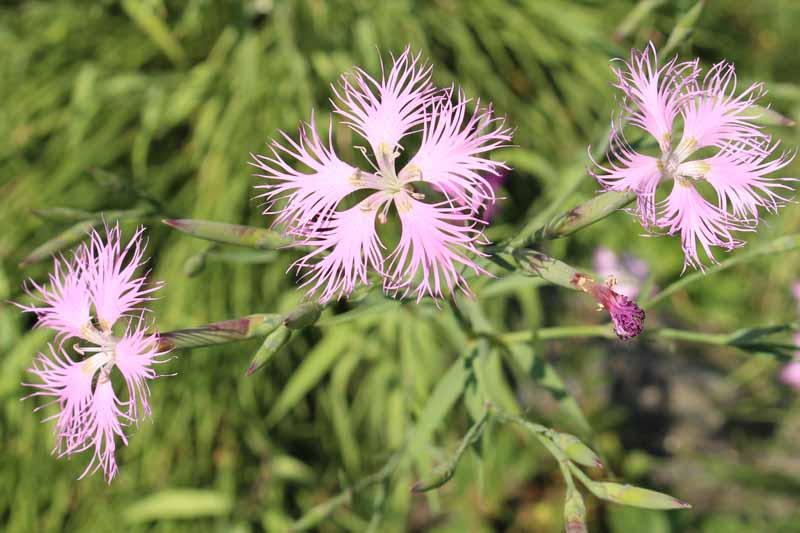
The plants enjoy a full sun location but can tolerate light, partial shade. They must have a well-draining location to prevent crown rot.
If needed, enrich the soil by working in two to three inches of organic material such as compost or manure to a depth of 12 inches.
Settle each plant so the crown is slightly above or even with the soil level.
Provide about one inch of water per week in their first growing season, watering in the mornings only. Drought-resistant once established, large pinks require additional water only during prolonged dry spells.
Growing Tips
The following growing tips can help keep your plants strong and vibrant:
- To improve drainage, amend the soil with landscape sand or pea gravel to add some grit.
- If your garden has a clay base, plant in elevated mounds to ensure well-draining soil.
- Provide one inch of water per week in the absence of rain while plants are becoming established.
Pruning and Maintenance
To encourage reblooming and maintain a tidy shape, be sure to deadhead or shear plants after flowering.
Deadhead promptly, or prune to reduce the flower stems and foliage by about one-quarter. For large plantings, it’s easier and quicker to shear plants entirely.
In early spring, apply a top dressing of organic compost or a slow-release, balanced or low-nitrogen fertilizer such as 10-10-10 or 10-20-10 (NPK).
D. superbus is a short-lived perennial, which means plants will flourish for up to four years, then begin to die out in the center as stems become semi-woody and begin to sprawl.
For continuous, renewed vigor, allow a few flowers to mature and self-seed in the fall. And reseed sterile hybrids every three or four years.
Or, when you notice a decline in vigor and floral display, typically in three to four years, start a collection of stem cuttings to transplant out when desired.
Apply a thick, three- to four-inch layer of leaf mold or straw mulch if very cold weather is anticipated. Remove the mulch in late winter.
Cultivars to Select
D. superbus is used in numerous breeding programs to produce delightful, perfumed flowers that bloom heavily in late spring, and rebloom sporadically through summer.
All of the varieties recommended below are hardy in Zones 4 through 8 unless otherwise noted. Here are a few popular choices:
Ambrosia
Like nectar for the gods, ‘Ambrosia’ flowers fill the air with a soft, sweetly spicy perfume.
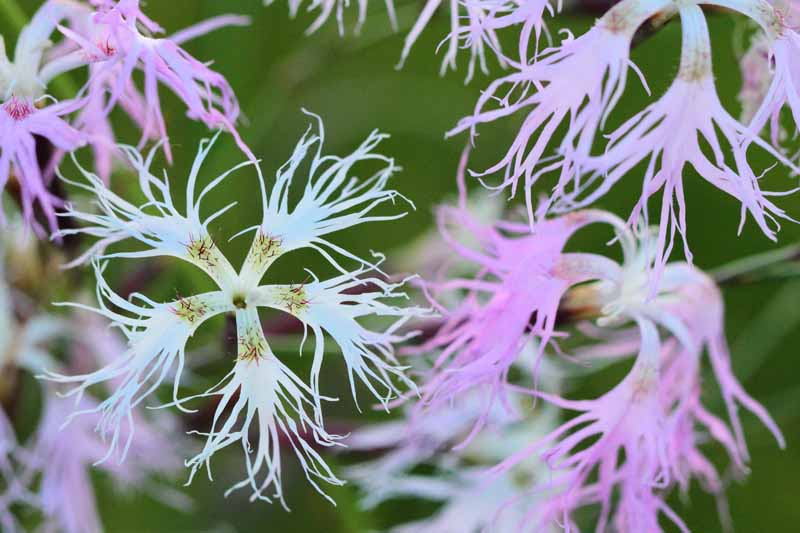
The delicate, long-stemmed flowers have a wispy, fanciful form with deeply cut, feathery petals in shades of lilac, pale pink, and white.
Plants reach a height of 10 to 18 inches.
Kahori
Low-growing and prolific, D. x ‘Kahori’ features masses of fringed, star-shaped flowers in vivid rosy-pink.
The silvery, blue-green foliage forms dense, clumping mats that grow eight to 12 inches tall.
Container plants are available at Nature Hills Nursery.
Kahori Pink
Charming and compact, Kahori® ‘Pink,’ aka D. x ‘Holkahoripink,’ has bright, bubblegum pink flowers with a white eye and toothy, serrated petals.
A standout for borders and edging or as fillers and spillers in containers, these plants grow six to eight inches and make a delightful addition to small bouquets and posies.
Find container plants at Nature Hills Nursery.
Kahori Scarlet
Kahori® ‘Scarlet,’ aka D. x ‘Holkahoriscarlet,’ has finely branched stems producing single, heavily colored, carmine-red flowers with lightly curled fringed petals and a cute, white eye.
Beautiful, silvery green foliage is evergreen in areas with warm winters, and forms thick, drought-resistant clusters once established. The low-growing plants reach a mature height of six to eight inches.
Container plants are available at Nature Hills Nursery.
Rainbow Loveliness
‘Rainbow Loveliness’ features beautiful, spidery blooms in a rainbow of carmine, mauve, pink, purple, and white with distinctive, contrasting eyes.
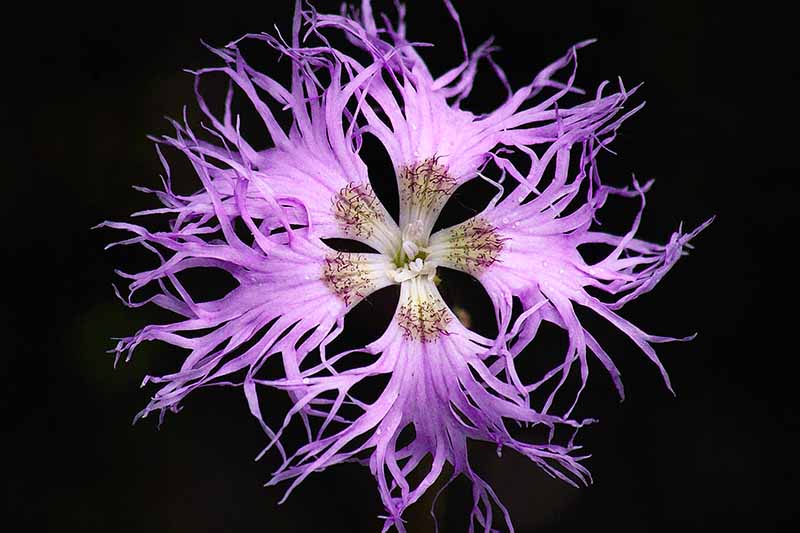
A clumping hybrid, the plants reach a mature height of 12 to 15 inches and the foliage remains attractive during the entire growing season.
Spooky
Frightfully lovely, ‘Spooky’ has weeping blooms with extreme, spidery fringes in colors of mauve, pink, scarlet, and white – and the red-toned blooms often have contrasting, rose-colored eyes.

The mounding clumps feature upright, finely branched stems that grow 16 to 20 inches.
This variety is hardy in Zones 3 to 8.
Managing Pests and Disease
Hybrids are developed for improved disease resistance, and perennial dianthus species like large pinks are mostly problem-free – but there are a few issues to watch for.
Crown rot is a fungal disease that can be avoided by ensuring plants are situated in a location with excellent drainage and adequate air circulation. Crown rot most often appears in wet soil and hot temperatures.
Easily transferred by hands, tools, and water, it’s difficult to control and infected plants should be removed and disposed of in the garbage.
Rust fungi from the family Pucciniales appear as small brick red, brown, or orange pustules on leaves and stems, causing the collapse of plant health. They form in overly wet or hot conditions and are aggravated by overcrowding.
Remove and dispose of rust-infected plants and don’t reuse the location for dianthus.
Common pests such as aphids and spider mites can be removed with a strong spray of water from the garden hose.
A natural method to control these sap-sucking pests is with the use of beneficial insects like ladybugs and lacewings. Or an application of a nontoxic insecticidal soap or neem oil can be used for persistent infestations.
Best Uses
For cut flowers, harvest as soon as buds open and promptly place them in water. Strip any leaves that will sit below the water line.
Large pinks can be used in a variety of garden settings, and being drought resistant, they adapt well to dry or rocky soils and well-draining slopes.
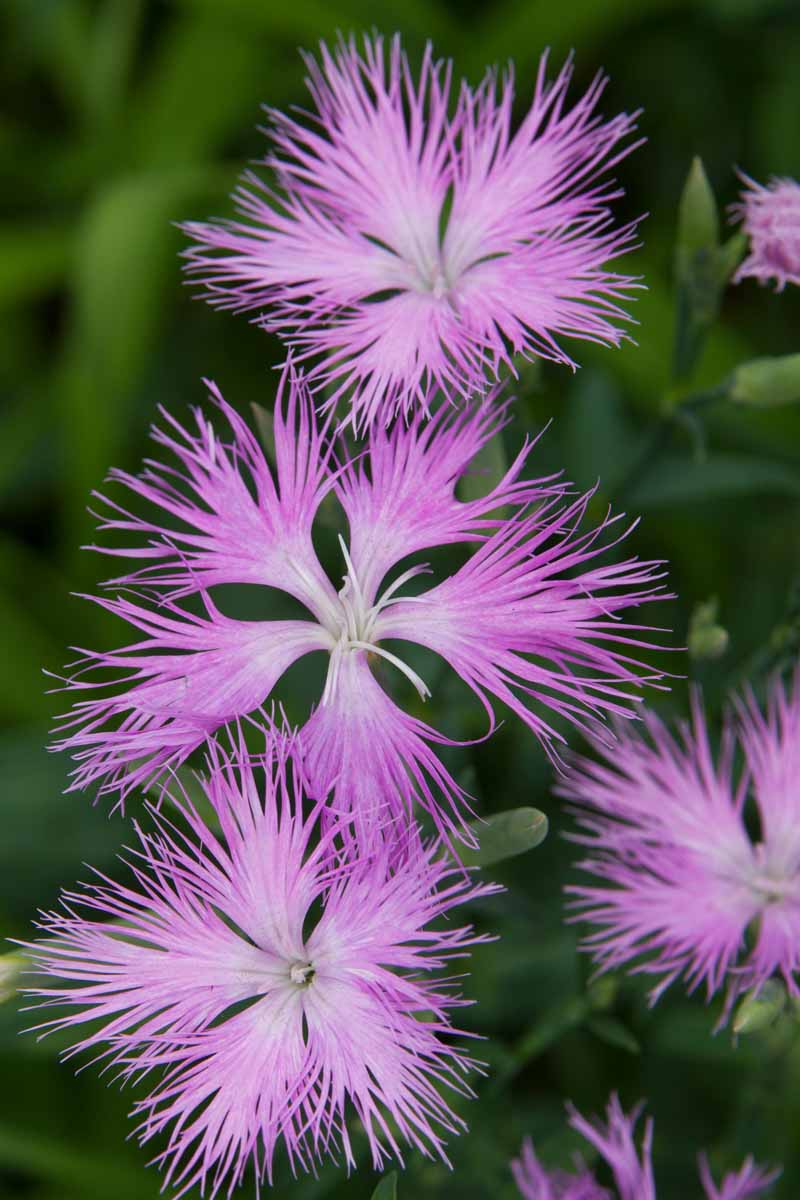
Low-growing cultivars are ideal for borders, containers, edging, and rockeries. They’re well-suited to ramble along banks and hillsides as a flowering ground cover and look spectacular spilling over the edge of a retaining wall.
Taller ones make a lovely addition to mixed beds and borders, and are a must-have for butterfly, cottage, and cutting gardens.
And be sure to locate plenty where their beautiful, perfumed flowers can be fully appreciated, such as beside garden benches, along pathways, and in patio pots and window boxes.
Quick Reference Growing Guide
| Plant Type: | Short-lived flowering perennial | Flower / Foliage Color: | Burgundy, carmine, mauve, pink, scarlet, white/silvery glaucous green |
| Native to: | Asia and Europe | Tolerance: | Deer resistant |
| Hardiness (USDA Zone): | 3-9 | Maintenance: | Low |
| Season: | Late spring and again in summer | Soil Type: | Humus-rich, gritty |
| Exposure: | Full sun | Soil pH: | 6.0-7.5 |
| Spacing: | 6-12 inches | Soil Drainage: | Well-draining |
| Planting Depth: | 1/8 inch (seeds), depth of container (transplants) | Attracts: | Bees, butterflies |
| Height: | 6-24 inches | Uses: | Beds, borders, containers, rockeries; cottage, courtyard, and cutting gardens |
| Spread: | 12-20 inches | Order | Caryophyllales |
| Growth Rate: | Fast | Family: | Caryophyllaceae |
| Water Needs: | Moderate | Genus: | Dianthus |
| Common Pests and Diseases: | Aphids, spider mites; crown rot, rust | Species: | Superbus |
Simply Superb
With cheerful colors and a marvelous spicy-sweet perfume, large pinks are simply superb in any garden!
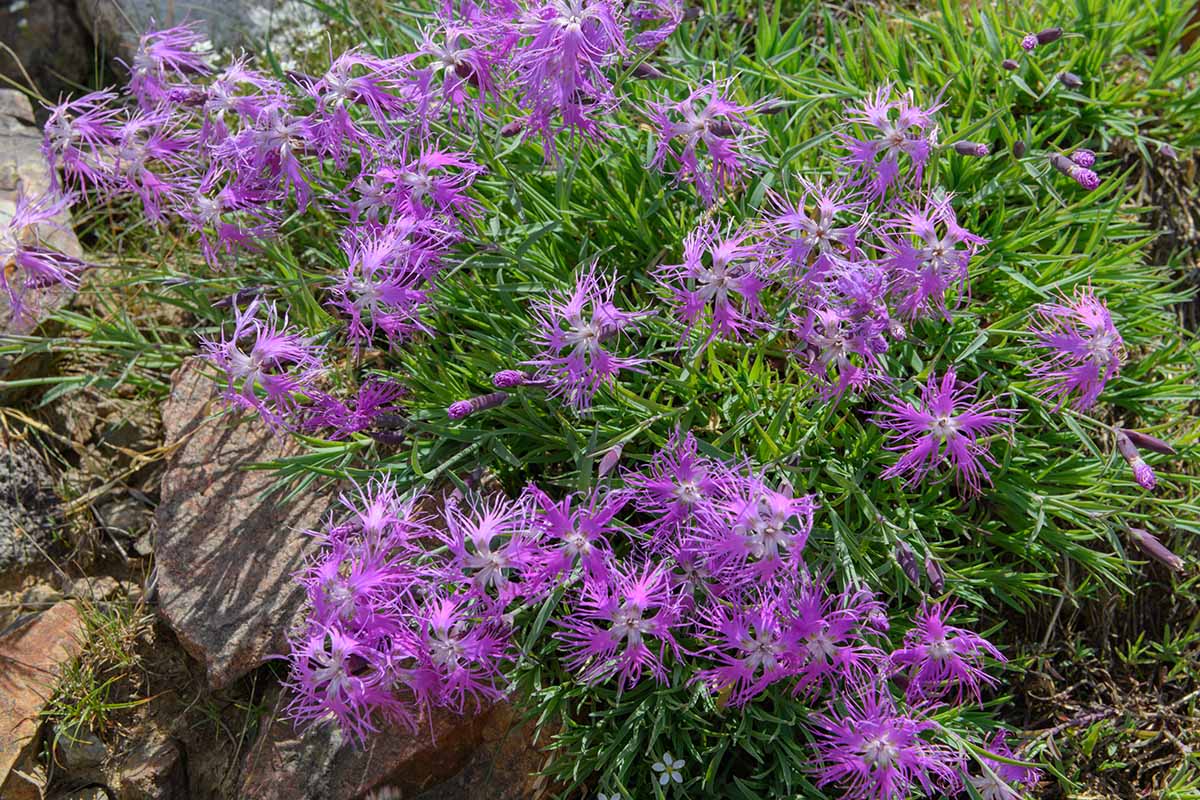
Easy to cultivate and drought tolerant, be sure to plant some close to windows and patio doors to fully enjoy these scented, sensational beauties.
And remember to remove spent flowers promptly for a second, lighter rebloom throughout the summer.
Do you folks have a favorite cultivar of D. superbus? Tell us about it in the comments section below.
And for more scented flowering perennials, be sure to check these guides next:
